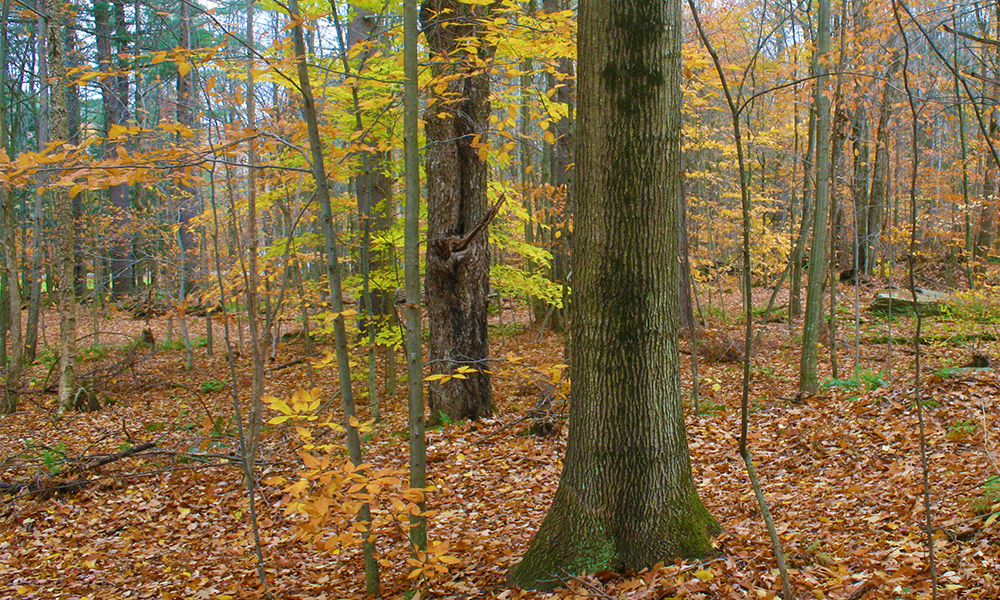Will Red Oak Dominate Future Vermont Forests?
Oct. 29th 2020Oak-hickory forests, possibly the most extensive forest type in the eastern United States, stretch into the northeastern United States. In Vermont, at the northern point of their geographic range, oak and hickory grow as minor components of the forest. Maple-beech-birch forests currently predominate in Vermont, but scientists predict that climate conditions will cause a shift to favor oak-hickory forests as the climate warms. By the year 2100, the oak-hickory forest, which includes northern red oak (Quercus rubra), is expected to gain a significant amount of suitable habitat within northeastern forests.
To learn more about the future of red oak in Vermont, a team of researchers at the University of Vermont (UVM) and the USDA Forest Service Northern Research Station, looked to the past. They studied tree rings to understand the impacts of climatic events on oak tree growth historically, now, and in the future.
“Tree ring data can highlight how growth relationships have shifted with changes in environmental cues, notably climate,” said Rebecca Stern, lead author on the research paper published in October 2020. “Trees near a species’ range limit, such as red oak in Vermont, provide a good indication of possible responses because these populations are often climate sensitive.”
The research team led by Stern, a recent UVM PhD graduate, identified climate factors that may most affect northern red oak growth in the state. The team collected increment cores (pencil-sized columns of wood, containing tree rings, extracted from tree trunks) from 213 mature red oak trees at 11 sites in the western valleys of the Green Mountains. Using tree ring measurements, they assessed tree growth in relationship to tree and forest characteristics and regional climate data.
Over the past century in this region, both temperature and total yearly precipitation have increased. The researchers assessed the possible sensitivities of red oak growth to these changes in climate in the species’ northern range.
From 1935 to 2014, growth of red oak generally increased across all 11 sites. However, tree rings showed temporary reductions in growth after multiple regional stress events: drought in 1964 and 1965, gypsy moth defoliation in 1977 and 1991, an ice storm in 1998, and a late spring frost in 2010.
Red oak has been growing well in Vermont and reached its greatest level of growth during the most recent decades. Summer moisture was one of the most important environmental conditions related to growth in this study. Red oak has large, early wood vessels and is able to conduct large volumes of water from roots to leaves.
The research team found that maximum summer temperatures had a negative effect on red oak growth. This combined with the importance of summer moisture points to summer drought as a potential limitation to red oak growth. Drought has been shown to have negative impacts on tree growth for many species in eastern North America, including red oak, as higher temperatures can mean drier conditions.
“Warmer average summer temperatures in recent decades, whether directly or by causing more rapid soil evaporation, may limit red oak growth in the future,” said Stern.
At the same time that warmer summer temperatures and associated drought may be having a negative impact on red oak growth, the researchers found that cooler summers have been related to increased growth during the past 40 years.
Vermont and the rest of the Northeast is expected to experience increases in temperature and precipitation throughout the 21st century. Computer model simulations show that projected increases in summer temperatures over a longer growing season will result in loss of water through greater potential evaporation from the soil and transpiration from leaves, causing increased stress to trees.
Increased potential evapotranspiration can create drought conditions, even in areas like the Northeast that are projected to experience increased moisture overall. Summer is the only season in which projections show a decrease in precipitation in the northeastern United States.
“This may not bode well for red oak since it grew best with high summer moisture throughout our study,” said Stern.
Projected precipitation increases are mostly in the form of rainfall in late winter, early spring, and fall. In the Northeast, the greatest increase in precipitation over the last century was in the fall, specifically October and November.
Red oak growth declined with fall precipitation in more recent decades. Red oak is a species that retains its leaves longer and can even retain dead leaves until the next spring. With favorable weather, this delayed leaf fall gives red oak a chance to photosynthesize and produce sugars and wood later in the growing season. However, more rain and accompanying clouds in the fall reduces sunlight needed to power photosynthesis.
In addition, with precipitation events in the Northeast becoming more extreme, increasingly heavy autumn downpours and associated wind gusts could hasten leaf fall. This reduces potential photosynthetic gain if leaves are lost earlier in the fall.
Red oak trees on Vermont sites investigated in this study have exhibited substantial growth, especially in recent decades. Yet, there may be more constraints, than recently thought, on red oak growth in the Northeast into the next century if summer heat and dryness and elevated fall rainfall become more extreme.
 ecoNEWS VT
ecoNEWS VT